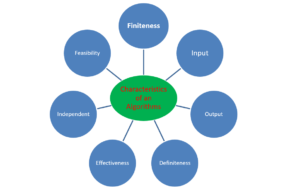Introduction to Algorithms
What is an Algorithm?
• An Algorithm is the finite set of sequential instructions to accomplished a task where instructions are written in a simple English language.
• It is called as a step by step solution of the problems.
• It is a well-developed, organized approach to solving complex problems
• It refers to logic of a program.
What are the Characteristics of an Algorithm?

An Algorithm should have the following characteristics:
1. Finiteness: – An algorithm terminates (end) after a finite number of steps.
2. Input: – An algorithm accepts zero or more input.
3. Output: – An algorithm produces at least one output and should match the desired output.
4. Definiteness: – Each step in an algorithm is unambiguous i.e. each
step should have a unique meaning.
5. Effectiveness: – An algorithm consists of basic instruction that are
realizable.
6. Independent: – An algorithm should have step by step directions
which should be independent of any programming code.
7. Feasibility: – An Algorithm should be feasible with the available resources.
Why Algorithms?
• Computer is quite fast, accurate and powerful machine to execute number of tasks.
• But computer has no intelligence (mindless or no thinking capability or no decision power) of its own.
• It can perform a task only in a manner in which it is instructed to do.
• During the process of solving any problem, one tries to find the necessary steps to be taken in a sequence.
• Steps can be written in some natural language.
• Natural language means the language which we use in our day to day life such as Hindi or English.
• Later, these instructions are written in some computer language such as C, C++, JAVA, PHP etc.
Example 1: Write an algorithm to calculate area and circumference of circle.
Solution: Let r is denote to radius of circle and circum is denote to circumference of circle.
1. Start
2. Read r
3. area = 22/7 x r x r
4. circum = 2 x 22/7 x r
5. Write area, circum
6. Stop
Example 2: Write an algorithm to find largest number among three numbers
Solution: Let a is first number, b is second number, c is third number and l is largest number which stored the result.
1. Start
2. Read a, b, c
3. If a > b then
goto step 4
otherwise
goto step 5
4. if a > c then
l = a
otherwise
l = c
5. if b > c then
l = b
otherwise
l = c
6. Write “Largest No “, l
7. stop
Example 3: Write an algorithm to display and find sum of first N terms Natural Number.
Solution: Let i is denote to generate natural number and sum is denote to addition of all-natural number and n is denote the last value.
Required algorithm is:
Step 1: Start
Step 2: Read n
Step 3: sum = 0
Step 4: i = 1
Step 5: Repeat steps 6 to 8 until (i<=n)
Step 6: display i
Step 7: sum = sum + i
Step 8: i = i + 1
Step 9: write sum
Step 10: End
